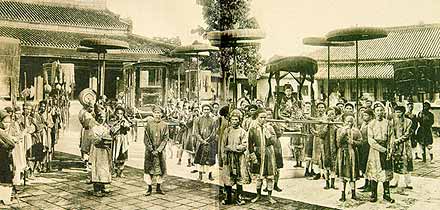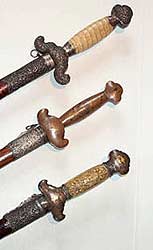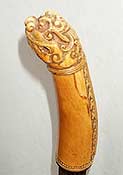Vietnamese Swords
By Scott M. Rodell

 |
Nineteenth
Century
Vietnamese Kiem,
Private Collection
|
Swords of Vietnam are a beautiful
and interesting cross of Chinese, Japanese, Thai and
in later designs, French influences. Vietnamese smiths
employed sophisticated methods of inlaying precious
metals and excellent chased silver for the fittings
of their weapons that are unique to the region. Finer
examples of both types of swords are often mounted
with ivory elephant handles. These grips are either
made of the tip of an tusk elephant or of sections
of elephant molars.
The kiem is a double edged
straight sword that has no parallel elsewhere in Southeast
Asia. Kiem are clearly a direct descendant of the
Chinese straight sword, or Jian, and mirror
their general shape and design very closely. The Vietnamese
kiem however are lighter with thin almost needle-like
blades. In some respects the Vietnamese straight sword
is reminiscent of European small swords and at first
glance one might mistakenly assume a European origin
for this weapon.
The Vietnamese saber, dao,
can be found in three varieties. Each originating
from one of the three foreign influences mentioned
above. From the 1400's to the 1800's, saber forms
followed the political divisions of the country. Sabers
from northern Vietnam (Tonkin) show a strong Chinese
influence. In blade form and design of fittings, they
descend from the Ming type LiuYe Dao - 'Willow
Leaf Saber'. These dao have a hand or hand
and a half grip.
|
|
|
Nineteenth Century
Vietnamese Tonkin (upper)
and Cochin sabers,
Private Collection
|
Dao of Cochin China are of
the two handed variety called dai dao. These
are related to other Southeast Asian saber such as
the Burmese and Thai dha. But they also show
a strong Japanese influence. It is interesting to
try and derive from where this Japanese influence
derives.
There has been a Japanese presence
in Thailand and coastal Vietnam beginning in the 15th
or 16th century. In Thailand, they served as mercenaries
and it is likely that they fell into piracy as they
did in other areas of Asia. In their roles as soldiers
or brigands, Vietnamese would certainly have come
in contact with weapons of Japanese origin.
|
|
|
Detail of Tonkin
(upper) and Cochin saber hilts.
|
The Japanese influence on Vietnamese
dai dao appears strongest in the fittings.
These Cochin sabers have guards shaped like the tsuba
of Japanese katana. Some are actually copies
of tsuba right down to the holes on either
side to allow for the utility knives present on the
side of Japanese sword scabbards (but are absent on
the dai dao). The Cochin dai dao also
have a habaki or collar at the forte as do
Japanese swords. Sometimes, oval, serrated washers
like Jappanese seppa are also positioned between
guard and collar.
 |
18th
Century
Vietnamese
Saber Handle
of Carved Ivory,
Private Collection
|
While these specific features are
drawn from Japanese sources, the overall design of
the Cochin saber is Southeast Asian. Their blades
form closely follow the Chinese Willow Leaf pattern
mentioned above. And the grips on these weapons are
also of round cross-section, like those of Thai and
Burmese dha. It should also be noted that the Vietnamese
sometimes utilized foreign blades. One example in
the Metropolitan Museum of Art's collection in New
York has a Japanese blade. Later kiem and dao
were also made with French blades.
The native forged blades of Vietnam
are pattern welded steel. These blades are forged
by a Chinese method known as qiangang - 'inserted
steel'. This type of blade construction employs an
inserted hardened steel cutting edge backed by a soft
steel core. These two components are sandwiched in
layered damascus steel. Some examples of parade swords
have blades of copper or brass. It is an open question
as to why a sword would be made with a non-functional
blade. I can only suggest at this time that they were
made for use in close proximity to the Annam emperor
to prevent their use in an assassination attempt.
By the later 1890's, one French traveler noted that
the quality of blades had declined.
|
|
|
|
Polearms Mitiary
Museum Vietnam
|
|
Vietnamese Weapons Terminology
|
|
Cung:
bow
Kiem*: straight sword
Dao†: saber
Dai-dao††: two-handed saber
Doan-dao††: dagger
* Jian in Mandarin
† The small "d" should be crossed
†† The small "d" should be crossed
In Vietnamese, the D is
pronounced like an English "d". A crossed D
is pronounced like "z" in the north, like "y"
in the south.
|
In the early nineteenth century another
foreign influence affected Vietnamese dao -
France. After the French bankrolled the establishment
of the Nguyen dynasty in 1802, lion-head pommels began
appearing. These sabers are essentially European in
design, with 'D' shaded knucklebows. This French pattern
is overlaid and decorated in the local Vietnamese
fashion, usually with embossed silver fittings on
the scabbard and hilt and mother of pearl inlay in
lacquer or rose wood scabbards. Other examples have
plain tortoise shell covered scabbards. This style
of saber has a scabbard chape with an usually sharp
upward accelerating curve terminating in a sharp end.
This is quite different from sabers of European design
which tend to have chapes with rounded ends. This
pointed chape is most likely a hold-over from Ming
Chinese influences.
Vietnam, lying like a dragon along
the coast between the Chinese Empire and seafaring
nations of Asia and Europe, has been a melting pot
of cultures for over millenium. The centuries of development
and varying cultural influences combine with excellent
local craftsmanship to produce unique swords of great
beauty. Today these overlooked treasures waiting to
be discovered by collectors and students of antique
arms.
© 1999 Scott
M. Rodell
Reproduced here with permission
About the Author:
Scott M. Rodell is Director of the Great
River Taoist Center and owner of
Seven
Stars Trading Co.. Rodell has over
20 years of experience in Taiji Quan. He is a disciple
student of Master Wang Yen-nien of Shanxi province
and also studied sword and push hands with T.T.
Liang and push hands and sanshou with William C.C.
Chen. Rodell has been teaching at Great River branches
in Northern Europe since '91 and was awarded 'Honored
Judge' rank by the Russia Wushu Federation (their
highest rank).He is author of "Taiji Notebook
for Martial Artists and "Chinese Swordsmanship
in the Yang Family Taiji Jian Tradition" (Fall
'01). He is also Moderator of the Chinese Swords
& Swordsmanship Discussion Forum at SwordForum.com.

back
to top
home
| about
us | magazine
| learning
| connections
| estore
|